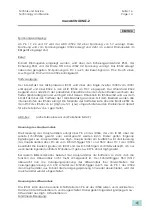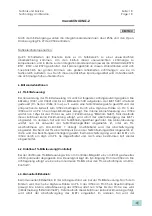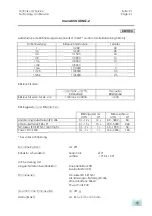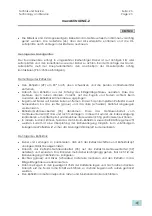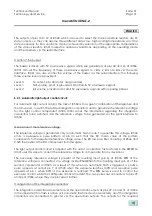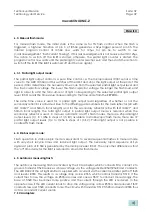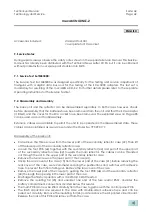
Technik und Service
Seite: 27
Technology and Service
Page: 27
mecablitz 40 MZ-2
ENGLISH
Thyristor Ty501 and its periphery form the protection circuit to prevent overcharging of the flash
capacitors C001 and C002. For this purpose, capacitor C508 is first charged via diode D515 to
approximately the battery voltage. While the flash capacitor is being charged, a voltage
proportional to the flash capacitor voltage is taken from pin 6 of the main converter transformer
and charges capacitor C508 via D506 and R575. If the flash capacitor voltage exceeds the
maximum permissible value, the voltage on C508 simultaneously rises above approximately 27V,
i.e. Zener diode D507 conducts and ignites thyristor Ty501. This connects the base of Tr507 to ground
via R517 and D519, causing it to conduct and cutting off the main converter transistor Tr503. The
main converter is thus switched off. Since the base current of Tr507 now flowing through D519 and
Tr517 is sufficient to maintain the holding current of Ty501, the protection circuit, once triggered,
can be reset only by disconnecting the power source from the flashgun.
3.1.3. Auxiliary converter:
The auxiliary converter around transistor Tr508 is a blocking oscillator which is driven by a
squarewave signal from the timer IC501. The auxiliary converter is switched on by the
microprocessor via the "DC-Conv. ON/OFF" stage in the ASIC. To do this, a high signal is generated
at pin 42 of IC504. This is first inverted with the digital transistor Tr514 and then connected as a low
signal to the base of Tr504, which conducts and supplies the auxiliary converter with voltage.
Two different supply voltages are generated on the secondary side of the auxiliary converter
transformer. A voltage of 6.8V is generated with the aid of diode D508 at pin 5. When the auxiliary
converter is running, this voltage supplies the SCA adapter, the exposure control signal, and the AF
measuring flash with power. With the aid of the voltage stabilizer IC502, it also supplies the
microprocessor and the ASIC. When the auxiliary converter is switched off, these parts of the circuit
are supplied with power, via diode D513, directly from the power source.
The second supply voltage is generated at pin 6 of the auxiliary converter transformer with the aid
of diode D511. The following series transistor Tr510 delivers a stabilized voltage of 24V at its emitter
and this is used to supply the IGBT driver stage and the photodiode of the light measuring circuit.
4. Triggering the flash:
4.1. IGBT:
The IGBT (
I
ntegrated
G
ate
B
ipolar
T
ransistor) is a new type of transistor which replaces the thyristor
circuits previously used for triggering the flash (series thyristor) and for controlling the light output
(quenching thyristor). The IGBT combines the advantages of a bipolar transistor with those of a
MOSFET. It is a powerful transistor capable of operating at high frequencies and the voltage control
via the gate requires very little power. To show its bipolar ancestry, the source and drain are still
called the emitter and collector, while the term gate is used instead of base to show its affinity with
MOS devices.
4.2. Main reflector trigger circuit:
In order to generate the high voltage pulse for the flash tube, capacitor C201 is charged via
resistor R403 almost to the flash capacitor voltage. Pressing the test button S313, or a low signal on
SCA contact 10 (from the sync contact of the camera), switches pin 29 of the microprocessor to


